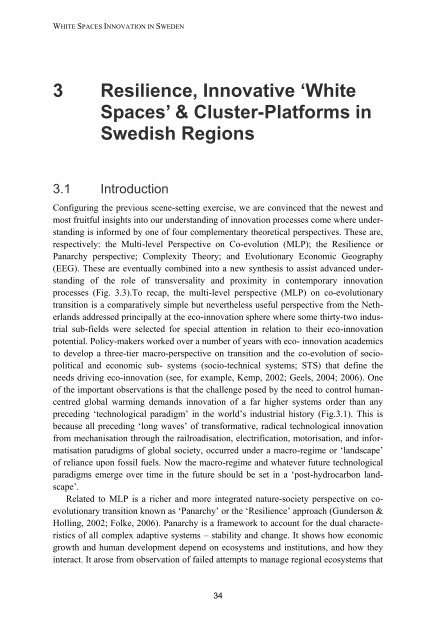White Spaces Innovation in Sweden - Innovation policy for ... - Vinnova
White Spaces Innovation in Sweden - Innovation policy for ... - Vinnova
White Spaces Innovation in Sweden - Innovation policy for ... - Vinnova
You also want an ePaper? Increase the reach of your titles
YUMPU automatically turns print PDFs into web optimized ePapers that Google loves.
WHITE SPACES INNOVATION IN SWEDEN3 Resilience, Innovative ‘<strong>White</strong><strong>Spaces</strong>’ & Cluster-Plat<strong>for</strong>ms <strong>in</strong>Swedish Regions3.1 IntroductionConfigur<strong>in</strong>g the previous scene-sett<strong>in</strong>g exercise, we are conv<strong>in</strong>ced that the newest andmost fruitful <strong>in</strong>sights <strong>in</strong>to our understand<strong>in</strong>g of <strong>in</strong>novation processes come where understand<strong>in</strong>gis <strong>in</strong><strong>for</strong>med by one of four complementary theoretical perspectives. These are,respectively: the Multi-level Perspective on Co-evolution (MLP); the Resilience orPanarchy perspective; Complexity Theory; and Evolutionary Economic Geography(EEG). These are eventually comb<strong>in</strong>ed <strong>in</strong>to a new synthesis to assist advanced understand<strong>in</strong>gof the role of transversality and proximity <strong>in</strong> contemporary <strong>in</strong>novationprocesses (Fig. 3.3).To recap, the multi-level perspective (MLP) on co-evolutionarytransition is a comparatively simple but nevertheless useful perspective from the Netherlandsaddressed pr<strong>in</strong>cipally at the eco-<strong>in</strong>novation sphere where some thirty-two <strong>in</strong>dustrialsub-fields were selected <strong>for</strong> special attention <strong>in</strong> relation to their eco-<strong>in</strong>novationpotential. Policy-makers worked over a number of years with eco- <strong>in</strong>novation academicsto develop a three-tier macro-perspective on transition and the co-evolution of sociopoliticaland economic sub- systems (socio-technical systems; STS) that def<strong>in</strong>e theneeds driv<strong>in</strong>g eco-<strong>in</strong>novation (see, <strong>for</strong> example, Kemp, 2002; Geels, 2004; 2006). Oneof the important observations is that the challenge posed by the need to control humancentredglobal warm<strong>in</strong>g demands <strong>in</strong>novation of a far higher systems order than anypreced<strong>in</strong>g „technological paradigm‟ <strong>in</strong> the world‟s <strong>in</strong>dustrial history (Fig.3.1). This isbecause all preced<strong>in</strong>g „long waves‟ of trans<strong>for</strong>mative, radical technological <strong>in</strong>novationfrom mechanisation through the railroadisation, electrification, motorisation, and <strong>in</strong><strong>for</strong>matisationparadigms of global society, occurred under a macro-regime or „landscape‟of reliance upon fossil fuels. Now the macro-regime and whatever future technologicalparadigms emerge over time <strong>in</strong> the future should be set <strong>in</strong> a „post-hydrocarbon landscape‟.Related to MLP is a richer and more <strong>in</strong>tegrated nature-society perspective on coevolutionarytransition known as „Panarchy‟ or the „Resilience‟ approach (Gunderson &Holl<strong>in</strong>g, 2002; Folke, 2006). Panarchy is a framework to account <strong>for</strong> the dual characteristicsof all complex adaptive systems – stability and change. It shows how economicgrowth and human development depend on ecosystems and <strong>in</strong>stitutions, and how they<strong>in</strong>teract. It arose from observation of failed attempts to manage regional ecosystems that34
















